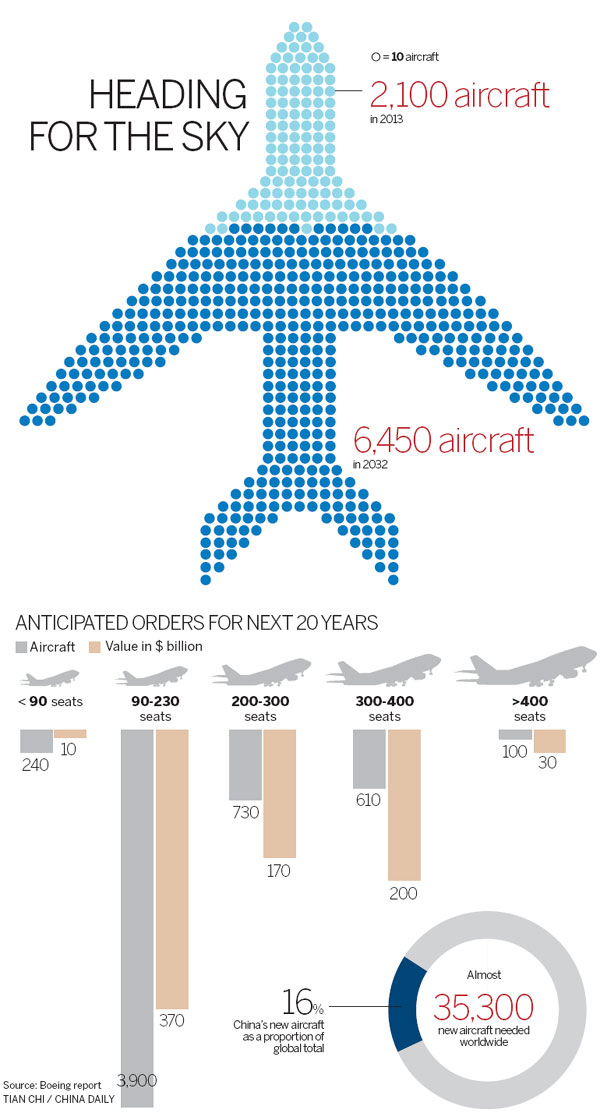Nation's aircraft fleet set to triple: Boeing
Updated: 2013-09-06 07:18
By Wang Wen (China Daily)
|
||||||||
Beyond Beijing, Shanghai and Guangzhou, there are more than 50 other Chinese cities with populations exceeding 3 million people. Fast economic development in these cities is spurring air travel demand.
China's top 50 cities will account for 12 percent of global economic growth in the next 10 years, since they already represent an "economic entity" valued at $2.9 trillion, said Kin Keung Fung, managing director Greater China of real estate firm Jones Lang LaSalle Inc.
Growing domestic and regional routes also will spur a strong demand for single-aisle airplanes, with total deliveries in that segment reaching 3,900 through 2013, according to Boeing.
Some analysts warned that the aircraft manufacturer's forecast is too optimistic, as China's economic growth is slowing and Chinese carriers actually have excess capacity.
Boeing has adjusted its forecast for China's annual GDP growth over the next 20 years. In 2011, it put the figure at 7 percent; now, the forecast is for 6.4 percent - still double the global rate.
"The economic growth slowdown will lead to a slowdown of air traffic and capacity investment, definitely," said Li Lei, a civil aviation analyst with China Minzu Securities Co Ltd.
In the second quarter of 2013, international passenger traffic in China, as the largest economy in the Asia-Pacific region, continued to decelerate, the International Air Transport Association said on Sept 3. China's domestic traffic also slowed in July from June, according to IATA.
"China's air travel market may be showing its first signs of weakness," IATA said in its monthly results for July.
Chinese carriers have to adjust their capacity from this year going forward, since they invested too much in capacity growth in past years, when the market was booming, Li said. "The capacity adjustment will be painful."
To maintain an acceptable load factor, ticket prices are being cut, and carriers' profits are falling, he noted.
But Chinese airlines may invest more to add capacity on international routes, especially in North America, Li said.
For example, the capacity of Air China Ltd for its North American routes increased 17.6 percent year-on-year in the first half, while capacity growth on the European routes was only 4 percent. The carrier even cut 24 percent of the capacity on its Japan routes.
wangwen@chinadaily.com.cn


 China, Russia a step closer on gas supply
China, Russia a step closer on gas supply
 18-year-old panda conceives triplets
18-year-old panda conceives triplets
 Testing times for G20 leaders
Testing times for G20 leaders Homemade choppers make aerobatic stunt debut
Homemade choppers make aerobatic stunt debut
 Shanghai's visa-free policy lifts tourism
Shanghai's visa-free policy lifts tourism
 Panda twin cub born at Atlanta Zoo
Panda twin cub born at Atlanta Zoo
 Xi, Mexican president meet for third time
Xi, Mexican president meet for third time
 Samsung unveils smartwatch ahead of rival Apple
Samsung unveils smartwatch ahead of rival Apple
Most Viewed
Editor's Picks

|

|

|

|

|

|
Today's Top News
Brazil asks for apology from US on spying
Xi calls for closer G20 ties
China, Russia a step closer on gas supply
Commuter aviation expected to take flight soon
Japan to test wall for leaking water
18-year-old panda conceives triplets
Films aim for success abroad
Low-budget education abroad for working-class
US Weekly

|

|





